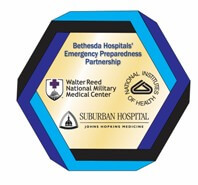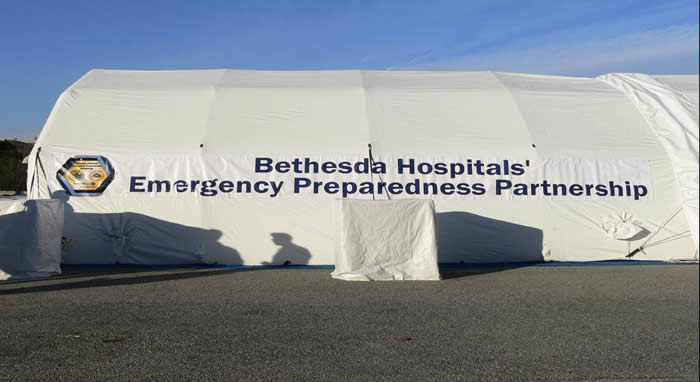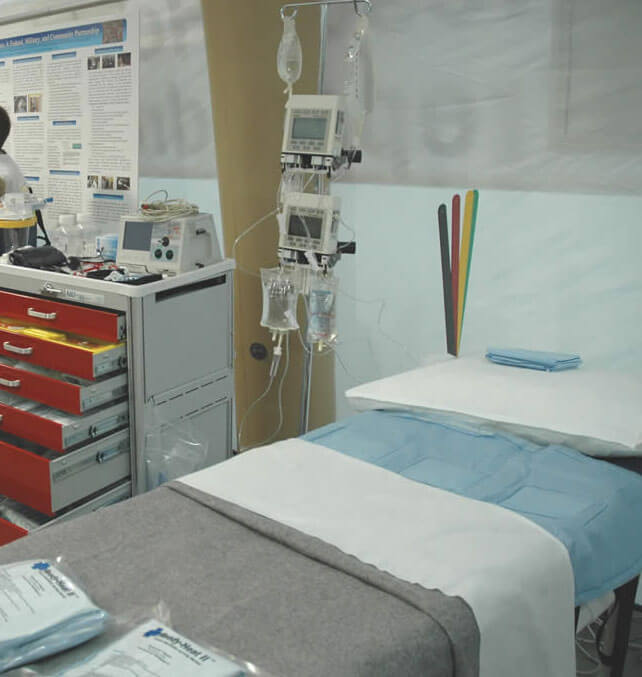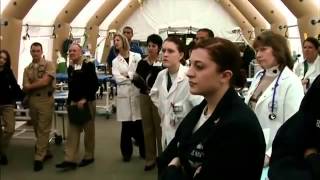Regional Emergency Preparedness
Suburban Hospital and Federal/Local Authorities Combine to Provide Emergency Response Services
Tips for Personal Emergency Preparedness
In 2003, the National Naval Medical Center, the National Institutes of Health Clinical Center and Suburban Hospital collaborated to create a sustainable infrastructure for efficient and effective local and regional disaster medical response. This collaboration is now known as the Bethesda Hospitals’ Emergency Preparedness Partnership (BHEPP) and has been recognized as a national model of committed, qualified and coordinated response in the event of a local, regional or national emergency.
Bethesda Hospitals Emergency Preparedness Partnership (BHEPP)
The (BHEPP) is recognized as a national model of committed, qualified, and coordinated response in the event of a local, regional, or national emergency.
BHEPP's strengths lay in the complementary assets of each institution, each of which had existing mature emergency preparedness plans and procedures as well as the necessary physical, human and intellectual resources to coordinate emergency health care for thousands of regional residents. The objective of the partnership was to expand surge capacity if each facility and create a plan that would provide emergency preparedness resources that would far surpass what any of the three institutions could provide independently. Thus, BHEPP can provide the highest quality and most efficient health care emergency services to the largest number of emergency patients in the shortest period of time.

Since BHEPP's inception, the leadership board has worked tirelessly to improve and expand its emergency preparedness response model. The partnership has purchased equipment and supplies for shared use, including mobile medical units that can be erected within hours. BHEPP also combines training and testing efforts, continually challenging their emergency response by integrating local, regional and national partners and enhancing relationships to assure successful outcomes. Part of the testing effort is to stage mass casualty exercises that involve federal, state and local emergency response providers, hospital personnel and interfacility medical transfers.
The first exercise, held in 2004, involved 450 participants and 20 EMS agencies. In 2005, the mass casualty exercise was expanded to be countywide and include eight hospitals, 4000 participants, 600 casualties, 30 emergency response units and several field response teams. In 2006, the exercise was again expanded with both regional and national focus. This Collaborative Multi-Agency Exercise (C-MAX 2006) integrated local, state, federal and military assets, involved 8000 participants with 600 casualties at eight area hospitals and included multi-agency helicopter flight operations, a remote incident command center in Scottsdale, Ariz., a Disaster Training Conference and the first Joint Forces Open House. The conference provided training on more than 40 topics for more than 2000 military and civilian personnel. Disaster drills are held each year so that new systems and procedures can be tested. In 2009, more than 5000 people were involved in the drill and a new radio communication system was tested.
BHEPP's Key Resources and Research
In the execution of an effective emergency response, the partnership has purchased the region's first 50-bed Inflatable Mobile Surge Capacity Shelter System. This tent structure has full generator capacity for heat and air conditioning and electrical service for all medical needs, including oxygen.
 The region's first 50-bed Inflatable Mobile Surge Capacity Shelter System
The region's first 50-bed Inflatable Mobile Surge Capacity Shelter SystemThe partnership has also researched and implemented many precedent-setting techniques, including:
- Communications: tested and implemented first Joint NCR Enterprise Land Mobile Radio System Network among local, federal and military agencies, and established the first off-site Remote Incident Command Center
- Patient Movement: researching the procurement of a multipurpose vehicle for the transportation of the Mobile Surge Capacity Shelter System, community outreach and education and for use as a mobile command center
- Transportation: researching feasibility of interconnecting the partners via bridge/tunnels for uninterrupted access of patients, staff and resources
A Model for National Preparedness
The Partnership's offers this model as an approach to facilitate national preparedness. Future initiatives involve the development of a research institute that validates our methodology. The model's portability for other communities is a key aspect of the collaborative strategies for sustaining readiness. As such, the BHEPP Board believes that this partnership serves as a model for other locales where proximity and complementary relationships exists among similarly diverse institutions.

Tips for Personal Emergency Preparedness
Is your family prepared for a major emergency, whether it is man-made or a natural disaster? Suburban Hospital wants to help you. Here are some tips to help your family prepare:
- Inform yourself about hazards and emergencies that may affect you and your family
- Develop an emergency plan
- Collect and assemble a disaster supplies kit
- Learn where to seek shelter from all types of hazards
- Identify the community warning systems and evacuation routes
- Include in your plan required information from community and school plans
- Learn what to do for specific hazards
- Practice and maintain your plan
Certain documents should be readily accessible in the event that you must leave your home quickly, including:
- Birth certificates and/or adoption papers
- Bank account numbers and bank contact information
- Credit card numbers and expiration dates
- Cash
In the event of a highly infective flu virus, it is important to:
- Wash your hands often
- Monitor travel advisory if you will be traveling out of town or out of the country
- Get your annual flu shot
- Avoid contact with people, birds or animals that are ill
- Stay home if you or your children are sick
- Eat only well-cooked poultry products
- Consider that the best treatment plan may be to stay at home and not expose yourself or others to greater illness
Get more information about preparing for an emergency situation:
- American Red Cross disaster preparedness
- Department of Homeland Security on general preparedness
- Flu.gov planning and preparedness

